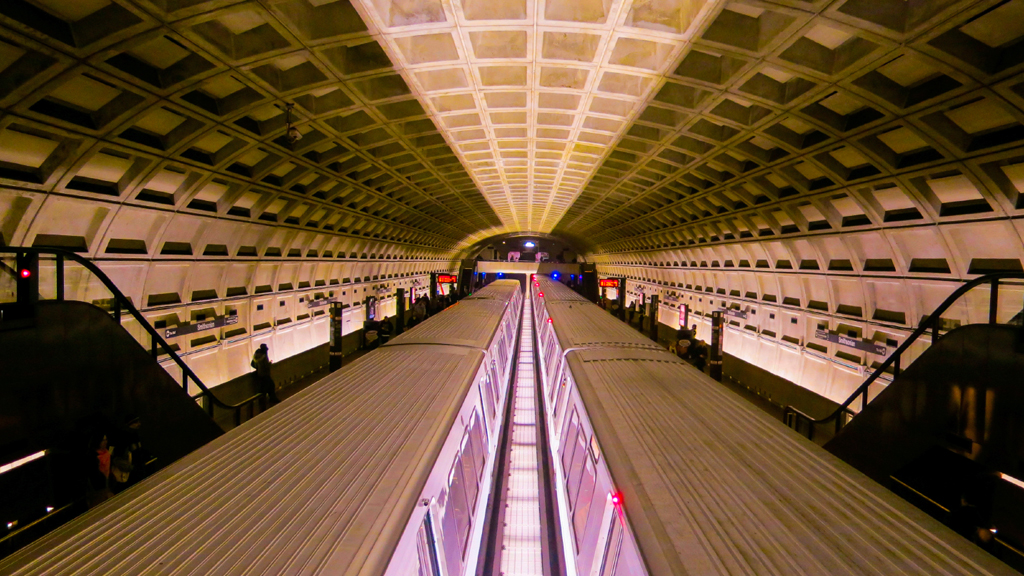Although Metro marked its 40th anniversary a couple weeks ago, no one is mistaking it for a very happy birthday. Between an aging fleet, a shutdown for emergency repairs, sagging ridership, and so many delays, Washington’s rail system is showing enough problems to fill a 214-page magazine. Overseeing Metro seems to take more time away from local officials’ other duties, and every snafu incites becomes fodder for conservatives looking for any excuse to bash government. Last month’s one-day shutdown, was, in the eyes of former House Speaker Newt Gingrich, a “perfect example of Bernie Sanders‘ big government theory and its failure.”
But at its birth, Metro was heralded as a model of what government could do well. To talk about what went wrong and how Metro might right itself, I called Zachary M. Schrag, a history professor at George Mason University and the author of The Great Society Subway, which came out around Metro’s 30th anniversary in 2006. While many Washingtonians remember the ’80s and ’90s as Metro’s “glory days,” Schrag says the first warning signs should have been seen very early on, and that some aspects of the system, especially its finances, were never that strong to begin with. But it’s not all doom. Metro’s “bones are good,” Schrag says, and with the right leadership and funding, it could become respectable again.
Metro is 40 years and a week old. Is there a short answer for how we got to where Metro is today?
The short answer is that things with moving parts wear out. What’s happening to Metro is part of the larger story of what’s happening to infrastructure. I think that sometimes people tend to focus on one particular system when all around them other infrastructure is being challenged. So we have most visibly right now, Memorial Bridge threatening to collapse into the Potomac if it doesn’t get another quarter-billion dollars. I think the story that may be even more disruptive than Metro is the Maryland section of the Beltway, where reports are that the deepest sub-pavement is nearing the end of its useful life and will have to be dug up and restored. All infrastructure needs maintenance and rehabilitation at some point. So in that case it’s not a huge shock that after 40 years Metro is in need of funds. What may be more dismaying is that we don’t have a better plan for how to get these funds or really how to get people moving while the rehabilitation is going on.
It almost seems like there wasn’t a plan after a certain point.
In all of my research I did not come across very clear plans for what would happen after 40 or 50 years, and I don’t know that many people build that way. There are some cases where you get plans for expansion. Very famously, when Eero Saarinen did the Dulles terminal he said we’ll start with a smaller terminal and someday there will be more traffic and we’ll expand it. And indeed that day happened and they dug up the old blueprints and expanded the terminal.
You write that everything changed with Kennedy’s election.
Under Eisenhower, there were plans for massive freeway systems in every city in the country. Congress had these maps in front of it when it decided in 1956 to fund what we now know as the Interstate Highway System with 90 percent federal funding. That was pretty much national transportation policy in the late 1950s. What Kennedy did was empower a bunch of local activists to consider alternatives. They weren’t starting from scratch, because even the Eisenhower-era planning commission had proposed a limited rail system to cover those routes where they thought highways wouldn’t be enough. But Kennedy’s people came in and said their priorities would be to have as much rail as possible and as few highways as possible.
This is an argument that is has been going on for decades.
Ironically one of the things the highway people said is “don’t worry about the highways, we can just cover them up and you won’t even know they’re there.” That is finally happening on I-395—$1.3 billion. So nothing is cheap. Yet rebuilding Metro is going to be billions of dollars. And if you look at the Big Dig in Boston, that actually eclipsed Metro as the most expensive public works project in US history. Anything you do is fantastically expensive, with the possible exception of bike lanes.
But Metro’s the thing that connects the region and one of the few things that unites the entire DC area at least culturally if nothing else.
One of the things that was interesting about the proposal of shutting down the lines is that some of the loudest objections come from the suburbs, including Fairfax. I think that is an indicator of how important Metro is not only to DC but the region as a whole. One could imagine an alternative scenario in which Fairfax County had built more highways and bridges over the Potomac, and the Fairfax government could say “Oh, go ahead. Shut down Metro forever.”
People talk about Metro’s “glory days” like some long-gone time. Were there ever really “glory days?”
In terms of operation, I would say the real glory started around 1978. Prior to that, most of the people riding had been on buses before, so total transit usage was still near its bottom. You have declining transit usage all the way down from World War II when people got cars, and the question was whether Metro could bring back transit as a whole. And the answer, starting in 1978, is yes. You get a greater share choosing to ride transit rather than rely on their automobiles. That’s a boost, quite frankly, from the Iranian revolution and gas lines. People were looking for alternatives.
 Metro had some of its most successful years because of the Iranian revolution?
Metro had some of its most successful years because of the Iranian revolution?
One of the heroes in my book is Egil Krogh, who was the founder of the Plumbers and went to prison for violating the civil rights of Daniel Ellsberg. Not necessarily the best public servant all around. But he also championed Metro in the Nixon White House. You get the Watergate guys to save Metro, and a few years later, Ayatollah Khomeini comes in and gives it a big boost as well. So give credit where it’s due.
In terms of operations, Metro ran smoothly for about 20 years. The system was constantly expanding. Every few years you get a new line opening up. Behind that optimism and smooth-running trains, you do have a perpetual financial crisis. That’s what I was trying to get at in the Politico piece. Right as Metro is attracting riders in the 1970s, first the Ford and then the Carter administration demand a reconsideration of all the unbuilt lines, saying we might want to cut the system and come out with something smaller. In the end, Congress had to appropriate a good deal more money in 1980. They were able to continue, but then you get the first warnings there would need to be rehabilitation down the line. So while there were golden years of Metro operation, I don’t think there’s ever been a golden age of Metro finances.
It seems there’s always someone in the White House or the legislative branch or some greater force that’s had it out for Metro’s funding? Is there a reason why WMATA’s never been able to get it together?
Cost overruns seem to be built into our culture. Everyone lowballs everything. You say infrastructure, but weapons systems tend to be vastly worse, if you look at the history of the F-35. The amount of mission creep and cost overruns there are astonishing there, enough to actually show up on the national budget.
For something we don’t actually use.
Right. It’s not just transit. You can talk about the Big Dig in Boston, you can talk about dams, they all seem to go over budget, and people say, “Well, there’s something wrong with mega-projects.” OK, what’s the opposite of a mega-project? How about a bathroom renovation? Do those go over-budget? Yes. All the time. And for some of the same reasons. Sometimes the homeowners decide there’s some beautiful tile they want to put in, and sometimes it’s because the contractor lowballs the bid. There’s nothing particular to Metro or to transit or even to infrastructure that makes things go over budget.
Jack Evans seems to say something about getting a dedicated funding source every five minutes.
Rob Puentes at Brookings talks about this a bunch too. If you go to the MBTA in Boston, they’ve got a dedicated funding source and they’ve got, I think, an $8 billion deferred maintenance deficit. I’m not saying a dedicated funding source wouldn’t help, but show me an American transit system that is in robust financial health before you show me a dedicated funding source is going to solve the problem. One of the problems with a dedicated funding source, depending on how you do it, it may be cyclical when you’d rather have it countercyclical. You could have a sales tax, for example, and there’s a recession and your sales taxes go down when in fact that’d be a great time to put some extra money into the system when labor and materials might be cheaper and where the additional payroll is going to help your city out of a recession. I think it’s not a simple answer.
Plenty of other subway systems around the country have gone through troubled periods. Around the time Metro was starting up, people thought New York’s subway was done for. Are there turnarounds in other cities that Metro should be looking at?
New York is certainly the one that comes up a lot, and there have been personnel executives going back and forth. People might look at London. I’m less sure of that, and there too I know there’s been some personnel swaps. Transit executives tend to rotate, and it’s probably a good thing they’re picking up ideas and solutions from various cities. I’m sorry I don’t know more about London, but certainly New York had its tough times and is doing somewhat better now. Every transit system has its issues. It is hard to keep these systems running, and again that’s not particularly different from any other kind of infrastructure.
Everyone credits Richard Ravitch for saving the New York subway. He’s unimpeachable. How much of it is finding the right person to be in charge of it all?
The ideal manager would be someone who knows project management in terms of capital and engineering. I think it’s in some way a harder job than almost anything in the world of government or the world of business, because you’re really doing both. It probably would take some kind of superhuman to do all elements of that job well. And this goes back to early in Metro’s history. People have great memories of Jackson Graham, but he quit before the first train ran, because that’s not how he saw his job.
How did he see his job?
He was in construction. He was there to make sure the tunnels got built and the tracks got laid, and when the bulk of that was done, he said, “I’m going to retire now.” In a sense, his job was easier. He didn’t have any operating responsibilities until the bus takeover in 1973, and from the people I talked to, he was not terribly happy about it. He was the last general manager to have any simple job, because he was just a builder.
He literally quit before he had to make trains run on time.
Exactly.
Paul Wiedefeld seems like he’s really trying to put some thought and effort into it in a way his predecessor didn’t.
What amazes me is that anyone runs for mayor of any big city, particularly in these declining Rust Belt cities. You have contested elections to be the mayor of Baltimore. There are actually people who want to be a big-city mayor, and I think it is a somewhat similar position. I think most mayors start on Day 1 with a line of crises and complaints going out the door.
Wiedefeld’s only been on the job for four months, but has he set himself apart from the other people who have had his job?
Obviously the one-day shutdown was pretty significant. I don’t know quite the precedent, but I know the military will do this at times. If there’s a series of accidents on submarines, then the admiral can say, OK, everyone, we’re going to review our procedures. But that’s less visible than the kind of disruption caused to hundreds of thousands of people who rely on Metro. It’s not the first time the system’s shut down, but to do that semi-voluntarily was unprecedented and obviously something of a gamble, and I think he’s getting very mixed reactions as a result.
Is this going to be the norm for a while?
I really don’t like to comment on future events, but I will say there is an echo here of the construction phase of Metro. Back when Connecticut Avenue was being dug up in the 1970s or 14th Street in the 1980s, people endured a lot of disruption in order to get a long-term benefit. In that case it was the surface streets that were being shut down for months or years, and people had to find a way around it. I think the rebuilding of Metro could have echoes of the original building, particularly if one of the ways to deal with the shutdown would be to take over more surface streets for buses. Just hypothetically, think about moving traffic or moving parking off some of the streets to compensate, and then you have drivers being inconvenienced in a way they were 40 years ago.
You go back 40 years and it seems someone’s always been complaining about Metro.
Pretty much. And if it wasn’t the riders it was the drivers who had to get around these construction sites, or the neighborhoods that didn’t like the rising property values or the increased density. Absolutely this is a work of politics, and it is going to be one that’s more controversial than, say, getting a water supply, though as we learned from Flint, even there we apparently can’t agree that people should have safe water.
It’s been about 10 years since your book came out. Has anything good happened in that time?
The Silver Line was a surprise. I wrote in the book that the biggest mistake in all of Metro’s creation was its failure to serve Tysons Corner, which even in the 1960s was projected to be this massive concentration of jobs and shopping. Certainly by the 1970s they had another swing at it and the data were even clearer in terms of the zoning and investment. At the time I was writing the book, the Tysons case was this lost opportunity, and now you can take Metro to Tysons. Now, it will take 30 years for Tysons to begin to really become more pedestrian friendly. Silver Spring was not much to look at when Metro first got out there in the 1970s, now Silver Spring is pretty much transit-oriented development as advertised.
This whole thing about Metro being the Great Society Subway, this crown jewel of transit systems, is that a reputation it can get back?
I think so. The bones are good. The stations are still grand, the sight lines are great, the planning is very good. Metro went where it was supposed to go, though unfortunately it’s created winners and losers. If you look at the redevelopment of DC, with gentrification you have people being displaced from neighborhoods and concerns about affordable housing. Obviously nothing is free. But if you look at the population of DC resurgent after decades of decline, that is Metro working as advertised. If you look at the development of Montgomery County and Arlington, that is Metro working as advertised. Eventually maybe Fairfax as well with the Tysons stations. Obviously the rail cars, if the 7000-series lives up to hope, we could get more reliability. All these electrical cables are sitting right there. You don’t have to jackhammer anything out or redesign things. Metro, unlike New York or London, doesn’t have any ghost stations that turned out to be not very helpful. A lot of the basics of Metro are sound physically. Whether the finances are sound is another question. Lyndon Johnson was constantly saying we are the richest nation in the history of the world, we can do these things. And we’re richer now than we were in 1965, but the question is are we going to pay to restore Metro to its glory?



















